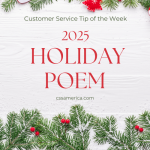A county manager talks about staff needing to have a “Servant Mindset” with the community. He is talking about government workers on the local level in tax collections, parks, social services, and the health department being servants of the residents of the community.
That’s his way of describing customer service. That’s his way of sharing his mental image of what it means to provide customer service.
To many people, this conjures up the image of someone subservient to the other, someone who defers to the other, someone dressing fancy, saying “Yes, Sir” and “Yes, Ma’am” and catering to the other person’s every whim. Could that possibly be the image he is referencing?
Well…yes.
We know that many government workers have a bad reputation for being slow or inconsiderate or even rude at times. And that reputation – fair or not – has to be turned around; changing that perception is not going to happen purely from some slick marketing or branding campaign. It has to happen through the thousands and thousands of interactions that occur on a weekly basis. That perception has to be changed through the reality that residents experience on a daily basis. It has to be based on each call, or e-mail, or face-to-face interaction which the community experiences. At some point, for government entities (and most businesses), reality is the ultimate determinant of perception.
So the manager strives to impact those interactions by impacting the mindset of each employee. If the employee takes the attitude that “I need to defer to the other” and “I need to dress professionally” and “I need to be respectful in what I say and how I say it,” then how that employee is perceived by the customer will improve. This mindset creates an underlying feeling in the conversation that the customer is important, they are being served, and they are being respected.
The next time your company is coming up with the next big thing to impact your perception and your brand, start first by impacting the mindset that each employee has toward their relationship with their customer.
Interested in improving your company’s customer service? See more information at: http://www.cssamerica.com/





















